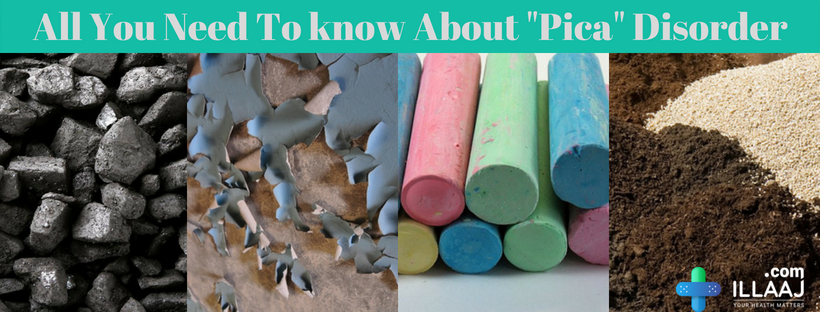Despite living in the world of technology and robotics most of us are not aware of the word ÔÇ£PicaÔÇØ or should I say we canÔÇÖt afford to take few seconds from our schedule to know more about the world of health. But in the frailty community, pica may come looking for you.┬á And if pica knocks on your door, questions are surely going to pop in your head. So, start reading now.
 What is Pica Disorder?
 Pica is a state of medical disorder under which people compulsively eat those food items which have no nutritional value. This disorder affects 10% to 30% of young children, ages 1 to 2. This is  most common in children and adults with intellectual and developmental disabilities, such as autism. A person suffering from this syndrome usually have a craving of eating nonfood items like coal, clay, sand, ice, flakes of dried paint or an abnormal appetite for some things that may be considered foods, such as food ingredients (e.g., flour, raw potato, starch, ice cubes). Besides children, this syndrome is also found in pregnant women. It is advisable to see a doctor right away if someone eats or have a craving for non-food items.
Pica is a state of medical disorder under which people compulsively eat those food items which have no nutritional value. This disorder affects 10% to 30% of young children, ages 1 to 2. This is  most common in children and adults with intellectual and developmental disabilities, such as autism. A person suffering from this syndrome usually have a craving of eating nonfood items like coal, clay, sand, ice, flakes of dried paint or an abnormal appetite for some things that may be considered foods, such as food ingredients (e.g., flour, raw potato, starch, ice cubes). Besides children, this syndrome is also found in pregnant women. It is advisable to see a doctor right away if someone eats or have a craving for non-food items.
 
Cause :
The scant research that has been done on the root causes of pica suggests that the majority of those afflicted tend to suffer some biochemical deficiency and more often iron, zinc or other nutrient deficiency, For example, anemia, or iron deficiency, may be the underlying cause of pica in pregnant women. Your unusual cravings may be a sign that your body is trying to replenish low nutrient levels.
Another reason is that people with certain mental health conditions such as schizophrenia and obsessive-compulsive disorder may develop pica as a coping mechanism. Besides these mental and nutrient deficiency conditions, some may even enjoy and crave the textures or flavors of certain nonfood items and which makes them eat same. Dieting and malnutrition can both lead to pica and in these cases eating nonfood items may help you feel full.
Diagnosis:
 When it comes to Pica it is difficult to get diagnosed as there is no specific test for it. The doctor usually diagnoses conditions based on history and your food habits. If you eat nonfood items please be honest to your doctor about same as this will help in accurate diagnosis. Your doctor may test your blood to see if you have low levels of zinc or iron. This can help your doctor learn if you have an underlying nutrient deficiency, such as anemia. Nutrient deficiencies may sometimes be related to pica.
When it comes to Pica it is difficult to get diagnosed as there is no specific test for it. The doctor usually diagnoses conditions based on history and your food habits. If you eat nonfood items please be honest to your doctor about same as this will help in accurate diagnosis. Your doctor may test your blood to see if you have low levels of zinc or iron. This can help your doctor learn if you have an underlying nutrient deficiency, such as anemia. Nutrient deficiencies may sometimes be related to pica.
Side Effects of Eating Nonfood material:
Eating certain nonfood items can sometimes lead to other serious conditions e.g. if you are having a habit of eating clay, you are indirectly consuming lead which is poisonous for humans. Other side effects include:
- Parasitic infections
- Intestinal blockages
- choking
- Stomach Ulceration
- Tooth Decay
- Tongue Pain
- General Weakness
- Missed Period
- Swollen Gums
- Fatigue
- Swollen Ankle
- Tired
- Pale Complexion
- Nausea
- Hair Loss
- Weight Loss
- Brittle Nails
If you are pregnant and you have craving for nonfood items, it can prove to be fatal for your baby. So, consult your doctor who can help in balancing the nutrient level of your body.
How Can You Cure Pica?

If you are connecting these symptoms with yourself then contact your doctor as soon as possible, before it is too late. Your doctor will probably begin by treating any complications youÔÇÖve acquired from eating nonfood items. Medication of pica truly depends on the cause of the disorder, If your doctor thinks your pica is caused by nutrient imbalances, he may prescribe vitamin or mineral supplements.
Your doctor may also order a psychological evaluation to determine if you have obsessive-compulsive disorder or another mental health condition.Depending on your diagnosis, they may prescribe medications, therapy, or both.
Pica outlook for people   :
Pica is usually temporary it often goes away in a few months without treatment. If a nutritional deficiency is causing your pica, treating it should ease your symptoms.
Sometimes it can long last for years, especially in people who have intellectual disabilities. Your doctor will help you understand the outlook for your specific case and what you can do to help manage the condition.
Communication and Pica:
Parents, medical professionals and educational professionals should communicate openly with each other about pica to ensure the safety of our children.
┬áIf you know other successful treatments for pica, please share them in us. We would love to hear from youÔǪ

